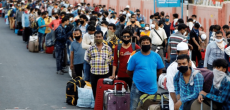[vc_row][vc_column][vc_column_text dp_text_size=”size-4″]Current climate change policies will expose billions to life-threatening heat. However, a global network of heat officers is addressing the issue in their own locations.
According to recent research published in the journal Nature Sustainability, if climate policies continue on their current path, approximately 2 billion people would live in hazardous heat conditions by the end of the century. That equates to 23% of the world’s estimated population.
If the climate continues to warm rapidly — a possibility under current policies — approximately 3.3 billion people could endure extreme temperatures by the end of the century.
The researchers from the University of Exeter in the United Kingdom and Nanjing University in China discovered that 60 million individuals are already exposed to harmful heat levels, defined as an average temperature of 29 degrees Celsius (84.2 degrees Fahrenheit) or higher.
How Do Hot Temperatures Harm Human Health?
According to the World Health Organisation (WHO), extreme heat can cause a variety of ailments and even death. Heatstroke and hyperthermia are two examples. Extreme temperatures aggravate chronic diseases and have an indirect impact on disease transmission, air quality, and key infrastructure.
Higher temperatures are especially dangerous for the elderly, babies and children, pregnant women, outdoor and manual labourers, athletes, and the destitute.
Also Read: The government is concerned that Israeli hackers are stealing data from Pakistanis.
The analysis discovered that even limiting warming to the lower Paris Accord target of 1.5 degrees Celsius above pre-industrial levels will still expose 400 million people to unsafe heat levels by the end of the century.
Even 1.5 degrees of warming will have a significant impact on people in India, Sudan, and Niger, while 2.7 degrees will have a massive impact on countries such as the Philippines, Pakistan, and Nigeria.
Calculating The Human Cost of Climate Change
According to the researchers, this work deviates from the tendency of modelling climate consequences in economic rather than human terms.
“It invariably distorts value away from human lives and towards centres of wealth,” Ashish Ghadiali, a climate activist and paper co-author, told DW, adding that economic modelling “places more value on a life in New York State than in Bangladesh.”
Most other models prioritise present populations over future ones, with inequality in global warming being “both globally distributed, but also intergenerational,” according to Ghadiali.
“It fundamentally values my life more than my children’s lives, and certainly more than my grandchildren’s lives,” he explained.
When researchers examined the effects of particular countries on deadly heat levels, they discovered that current emissions from 1.2 average US citizens condemn a future human to live in terrible heat. Despite high emissions, the US population faces a significantly smaller threat from disastrous temperatures.
How Can People be Protected From Extreme Heat?
Previous research has indicated that cities are especially prone to harmful temperature rises due to the “heat island effect.” Buildings, roads, and infrastructure absorb and radiate more heat from the sun than natural surroundings such as woods and bodies of water, elevating urban temperatures by up to 15 degrees Celsius in some circumstances when compared to rural locations.
To deal with the anticipated rise in temperatures, cities around the world are creating the new position of chief heat officer. Cristina Huidobro, who will take over as mayor of Chile’s capital Santiago in March 2022, is one of them.
“Many cities around the world experience extreme heat, but the solutions and approaches are very, very local,” Huidobro told DW.
Nonetheless, according to Huidobro, they all pursue a three-pronged strategy: preparedness, awareness, and adaptation.
Heat waves can be classified in the same way as other natural disasters, or an alert level might be set to trigger a specific city response.
Huidobro stated that spreading awareness about the dangers of heat is an important aspect of his job.
“Taking care of yourself during an extreme heat event is really simple — drink water, seek shade, and rest,” she explained. “No one should perish as a result of extreme heat.”
The third pillar involves adapting the city to the new reality of high temperatures, primarily by creating more green spaces.
Santiago has just initiated an urban forestry project to plant 30,000 trees throughout the city and develop techniques to treat trees as part of the city’s infrastructure.
“Trees, trees, trees everywhere.” “It brings more green into the city,” Huidobro explained.
However, planting trees is not as simple as many people believe.
“We’re putting trees in really dense streets, like the city’s main avenues, where there’s a lot of cement.” You need to dig a hole and undertake some actual civil work.”
It is also not a quick fix for urban heat because trees take time to grow.
“The whole idea is to try to plant the shade that we’re going to have in the next 20 or 30 years,” Huidobro explained.
The US Cities Fighting Extreme Heat
In the United States, where prior studies have indicated that 12,000 people die prematurely from heat each year, three chief heat officers have been named thus far, in Phoenix, Miami, and Los Angeles.
The Californian city of Los Angeles, which is listed as the most vulnerable to natural disasters such as heat waves, recently initiated a drive to develop additional “resilience hubs” in high-risk regions with shade and cooling powered by renewables. It already has a network of cooling centres, mostly in libraries, where people can go to cool off throughout the summer.
They are also developing a heat wave early warning system.
Phoenix, located in the Sonoran Desert, is working on a number of adjustments, including the construction of cooling pavements with a unique sealant that reflects the sun. The sealer keeps the night air colder by making the walkways several degrees cooler to the touch.
The city of Miami, Florida, is planning significant urban tree-planting efforts and has spent millions of dollars on air-conditioning equipment for public housing tenants while simultaneously offering financial aid to help low-income households meet their energy expenses.
However, according to Santiago’s Huidobro, air conditioning is often a last alternative for adaptation due to its climate implications.
Santiago intends to plant 33 “pocket forests” that will be utilised as climate shelters, particularly around schools and health care facilities. These are an alternative to the air-conditioned cooling centres that are being built in the United States and Europe.
“During a heat wave, people can go inside these nature-based cooling centres and get their shade, rest, and drink water,” Huidobro explained.[/vc_column_text][/vc_column][/vc_row]











